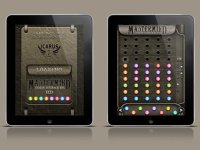Games in the Mathematics Classrooms: There’s an App for That!
Last month, the Institute of Play released a 160-page whitepaper on successfully designing and implementing video games as classroom assessment tools. It is widely hoped that the Institute's study, along with further research by SRI, will prove conclusively that cognitive skills are significantly improved by playing educational video games. This was not news to the math education community, which has known about the benefits of games in the classroom for a long time. Back in 2004, a study by Tisa Lach and Lynae Sakshaug had already shown that middle school students made significant improvements in algebraic reasoning, spatial sense, and problem-solving abilities after playing biweekly sessions of popular tabletop games such as Connect Four, Mastermind, Rush Hour, and Guess Who.
Slice It!
Credit: Com2uS USA, Inc.
With all of the evidence pointing toward the effectiveness of game-based learning, one could reasonably ask why educational and board games are still used so sparingly in American math classrooms. As far as video games are concerned, cost and logistical issues around software installation remain a barrier to adoption. As for board games, they are admittedly cumbersome and hard to deploy in a classroom setting. Though video games hold a lot of promise and board games are wonderful tools (especially in elementary mathematics), I am here to promote a third option that is easier and more affordable than both video games and board games -- tablet-based apps derived from classic thinking games, puzzles, and problems in recreational mathematics.
Puzzle apps are fantastic tools for training students to be creative mathematical thinkers. In addition, well-designed puzzle apps align perfectly with the Common Core Standards for Mathematical Practice:
- Make sense of problems and persevere in solving them.
- Reason abstractly and quantitatively.
- Use appropriate tools strategically.
- Look for and make use of structure.
- Look for regularity in repeated reasoning.
Just a Few Puzzles
Set Pro
Credit: Set enterprises, Inc.
The purpose of this post is to encourage more teachers to try puzzling sessions in class, and below I provide a selection of great apps. However, I must warn you that none of these apps align well with standard textbook chapter headings. Some teachers who use them will try to merge them into lessons on topics that overlap with the skills taught by the app(s). Others may feel that puzzling activities should be reserved for dedicated "enrichment" sessions. Puzzling activities require some planning, but in order to help you get started, here is a list of apps selected for their mathematical depth, game appeal, and ease of deployment. If you have access to iPads or tablets, get these! They are all game-like, colorful, and bundles of fun.
Classic Games
- iOS
- Android alternate version
- iOS
- Android alternate version
- iOS ($4.99)
Gamified Puzzles
Number-based Puzzles
5 Qualities of a Good Puzzle App
The list above does not even scratch the surface of all the good apps that are out there. For those of you who want to go beyond this list, visit middle school math teacher Tom Cutroffelo's great blog about puzzle apps. In general, here are some things to look for when identifying good puzzling apps:
1. Depth of the Underlying Mathematics
The most effective math games are those with a rich mathematical structure. Take the Rubik's Cube, for example. Students may not be aware of it, but this puzzle demonstrates advanced mathematical principles in action (group theory and permutations).
2. Interactive and Fun
Not all problems in recreational mathematics can be made interactive. A lot of math apps are quite static and no more exciting than pen-and-paper versions of the same puzzle. Teachers should try to select apps that are inherently interactive and contain colorful animated graphics.
3. Visual
The great thing about many of the apps in our list is that the patterns and structures within the games are made visually apparent. Let’s use the Rubik's Cube once again as an example. (The Cube does exist on the App Store even though I didn't list it above.) What mathematicians love about the Cube is that its complex structure is revealed through the manipulation of colors or shapes. The Cube brings the abstract mathematics of permutations to a concrete level appropriate for small children.
4. Easy to Learn, Hard to Master
The games listed above all ramp up smoothly and allow the player to quickly achieve basic proficiency. They then challenge the player to apply those skills to solve harder levels of the same problem. Avoid puzzles that get too hard too fast or don't provide enough opportunities for intuitive breakthroughs.
5. Good Puzzling Apps Operate on Multiple Levels
Puzzles with deep mathematical structure tend to appeal to all age groups. They also have more longevity because they are linked to overarching mathematical principles as opposed to a single piece of the syllabus. For example, elementary school students might simply try to solve one face of the Rubik's Cube, while middle schoolers might try to solve the whole cube. High schoolers can begin to investigate the mathematics behind the cube (elegant curriculum kits are distributed and sold by Seven Towns Ltd., the makers of the Rubik's Cube), while college students can take entire courses on the mathematics of the Cube.
If you find or already know of some other great apps, don't forget to share them by posting the links in the comments below. Happy puzzling!
